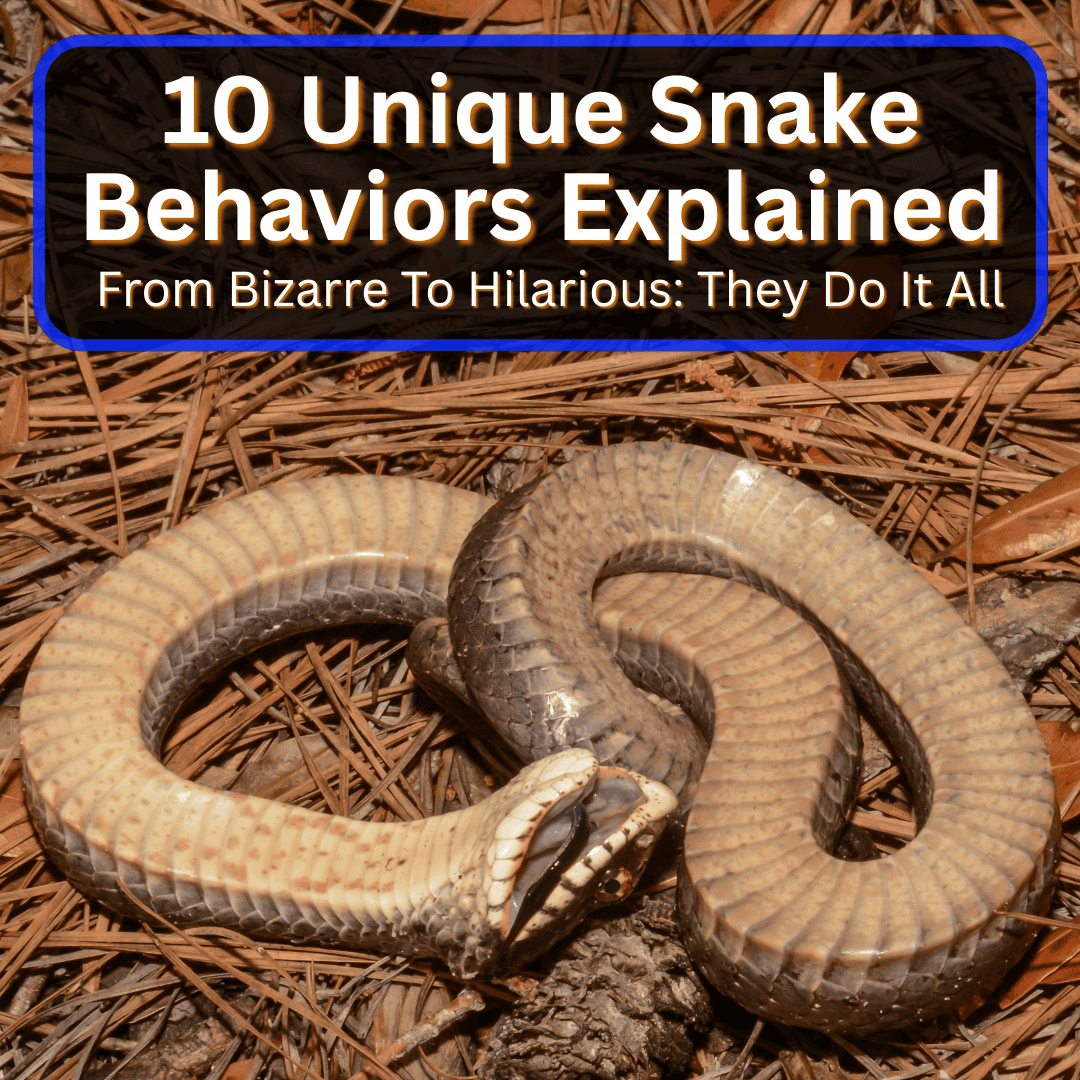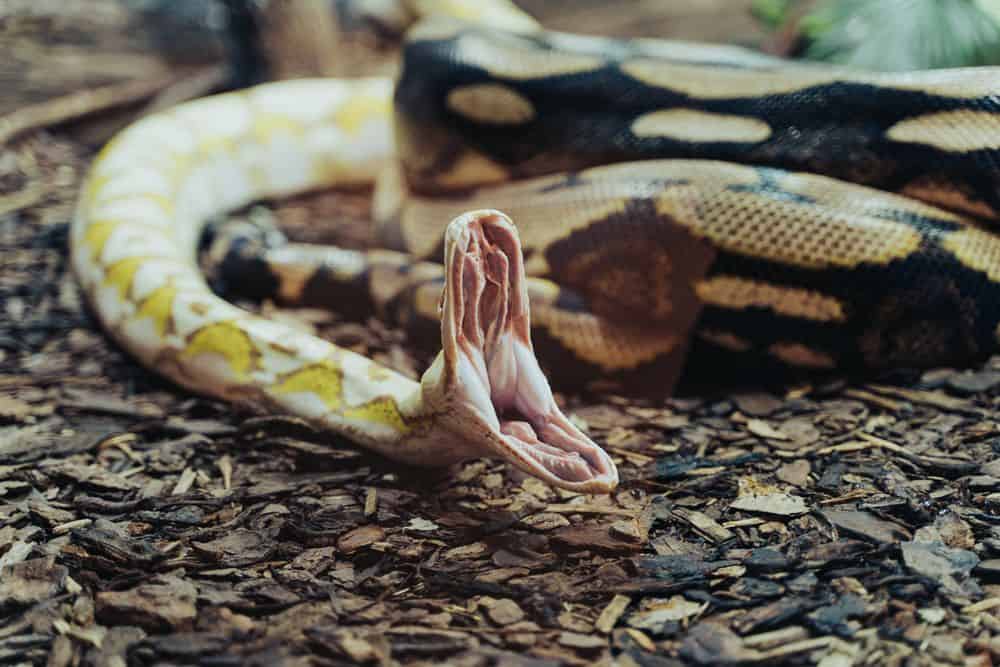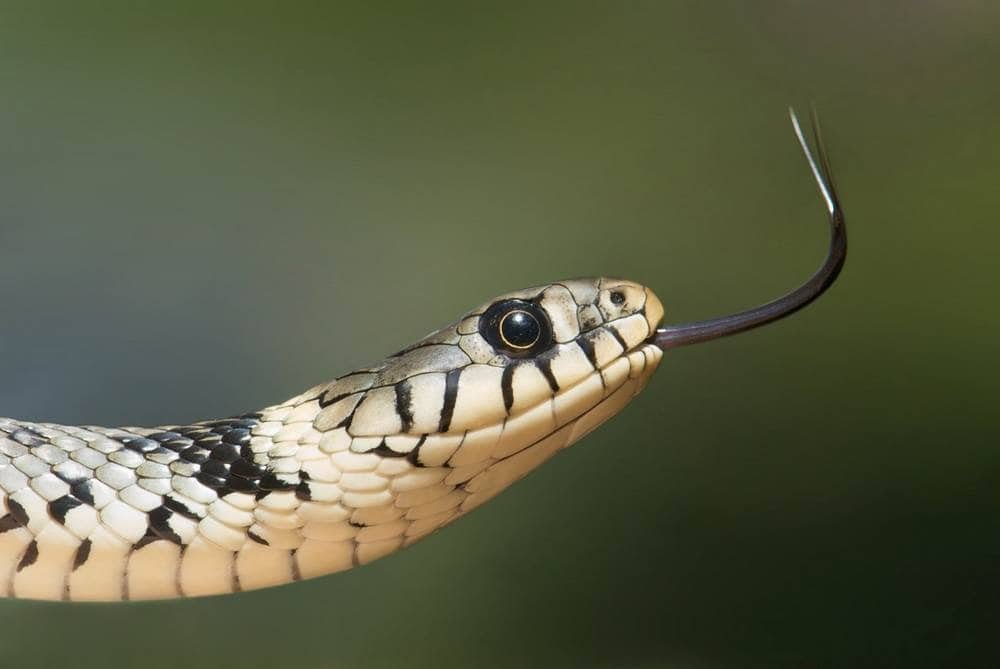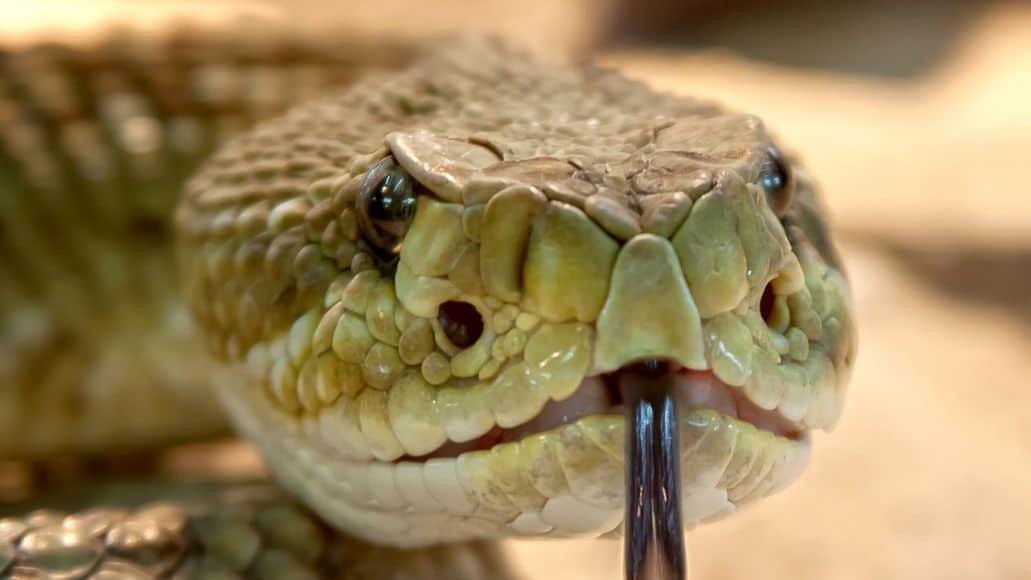
These reptiles do much more than just slither and bite.
They can glide through trees, fake their own death, and even mimic other dangerous species to stay safe.
Learning about these unique snake behaviors helps you understand how these amazing creatures survive and communicate in their world.
From using their tongues to smell the air to vibrating their tails like rattlesnakes, snakes have developed clever ways to hunt, hide, and find mates.
You’ll discover how they use heat sensors, body language, and even theatrical performances to make it through each day.
Unique Snake Behaviors Explained
Let’s take a closer look at 10 of the most unusual snake behaviors and find out exactly why these reptiles do what they do. Because there is a good explanation for all of it.
1. Gliding Flight
You might think all snakes stay on the ground, but some species can actually glide through the air. These amazing snakes are called flying snakes or gliding snakes.
The paradise tree snake is the most famous gliding snake. You can find them in Southeast Asia, living high up in the tree canopies.
When a flying snake wants to glide, it launches itself from a tree branch and flattens its body to create a wider surface that catches the air. The snake wiggles its body in an S-shape while gliding, which helps it steer and stay airborne longer.
Some flying snakes can travel up to 100 meters from tree to tree—longer than a football field! They glide mostly to escape predators or to hunt for prey in new trees. Their gliding speed hits about 11 meters per second, so they’re surprisingly quick as they move through the air.
2. Playing Dead
When you encounter a hognose snake that feels threatened, you might witness one of nature’s best acting performances. These small snakes flip onto their backs and lie completely still, mouths open, tongues hanging out, sometimes even drooling to look extra convincing.
The real twist is the smell. The snake releases a foul-smelling liquid from glands near its tail, making it seem like it’s been dead for a while. Most predators prefer fresh prey, so that stench usually sends them running.
Thanatosis, as it’s called, is a last-ditch trick for snakes that can’t outrun or fight off bigger predators. If you spot a snake doing this, just let it be—it’s not hurt, just putting on a show.
3. Yawning Wide

When you see your snake opening its mouth really wide, it might look like it’s yawning. But snakes don’t yawn because they’re tired. This behavior, called mouth gaping, is actually about smelling the air.
Snakes have a Jacobson’s organ on the roof of their mouth that detects scent particles. By gaping, they collect more of these particles, learning about what’s around them.
It’s like tongue flicking, just on a bigger scale. Some can open their mouths to a wild 140-degree angle. If a snake smells prey, it might gape to prepare for a big meal and stretch its jaw muscles at the same time. This helps them hunt and stay alert to changes nearby.
4. Tongue Flicking

When you watch a snake, you’ll notice its tongue constantly flicking in and out. That’s not random—it’s “tasting” the air. The forked tongue grabs scent particles from the ground and air, then delivers them to the vomeronasal organ in the roof of the mouth. That organ reads those chemical messages, almost like reading clues in a mystery novel.
This helps snakes find food, sense danger, and even locate mates. The forked shape lets each tip pick up chemicals from slightly different places, so the snake can tell where a smell is coming from.
Water snakes even change their tongue flicking style when they move from land to water. It’s honestly pretty cool how much info they get from a single flick.
5. Heat Sensing Pits

You might wonder how pit vipers hunt so well in total darkness. Well, they have heat-sensing pits between their eyes and nostrils. These little holes are packed with nerve endings that pick up infrared radiation from warm bodies.
When a mouse scurries by, those pits sense the heat, even if you can’t see a thing. The snake’s brain blends this heat data with what it sees, building a mental map of its target. It’s almost like the snake’s wearing invisible night-vision goggles.
Pit vipers can even strike at heat sources when they’re blind, which makes them terrifyingly efficient hunters at night. Those pits are so sensitive, they can detect temperature shifts of just a few degrees—handy for finding prey hiding out of sight.
6. Tail Vibrations
Many snakes shake their tails when they’re scared or threatened—not just rattlesnakes. Non-venomous snakes often vibrate their tails against dry leaves or rocks, creating a buzzing sound that mimics a rattlesnake’s rattle.
Fox snakes are notorious for this trick. People often mistake them for rattlesnakes just because of the sound. When you hear that rattling, the snake’s trying to convince you (or any predator) that it’s dangerous.
Even some venomous snakes like copperheads buzz their tails, though they don’t really need to pretend. Tail vibration is a way for snakes to say “back off” without getting into a fight. It’s simple, but it works.
7. Mimicking Other Species
Some harmless snakes go out of their way to look scary. They copy dangerous species to stay safe. This is mimicry—non-venomous snakes imitate the colors, patterns, and actions of venomous ones, hoping predators won’t risk it.
The coral snake, for example, has about 150 copycats. Scarlet kingsnakes and Sonoran Mountain kingsnakes both sport similar red, black, and yellow bands. Some snakes mimic behaviors too—eastern hognose snakes flatten their heads and hiss like rattlers when threatened.
The false water cobra and oriental rat snake even spread their necks to look more menacing. Others shake their tails in dry leaves to fake that rattlesnake sound. Mimicry keeps predators guessing and gives harmless snakes a fighting chance.
8. Unique Mating Rituals
Snake mating season is a wild show. Females release pheromones into the air, and males track them down using their forked tongues. Sometimes, you’ll see two males twisting around each other, trying to push the other down—this “combat dance” decides who gets to mate.
The winner performs courtship moves, like rubbing his chin on the female or waving his tail. Some males, especially vipers, try to top each other by twisting around in a show of strength.
Most of this drama plays out in spring and summer. These rituals help snakes find partners and ensure the strongest genes get passed on. Nature doesn’t mess around with matchmaking, huh?
9. Constriction Patterns
If you watch snakes hunt, you’ll notice each species has its own style of wrapping up prey. Boa constrictors, for instance, can actually feel their prey’s heartbeat as they squeeze, so they know when to let go.
Most constrictors start with a bite, then quickly throw a loop around their target, adding more coils without overlapping too much. They press their bellies and sides against the prey’s chest, making what’s called a ventral-lateral coil.
Constrictors have a tougher time with reptiles than mammals or birds, since reptiles are cold-blooded like them. Wrapping up prey takes a lot of energy, and sometimes the prey fights back. It’s not always as easy as it looks.
10. Hissing And Puffing
When a snake hisses, it’s trying to avoid a fight. Hissing is its way of saying “stay away” before things get ugly. Snakes can’t make many noises, so this is pretty much their go-to warning.
The hiss comes from air rushing through the throat—a simple but effective alarm. Many snakes also puff up their bodies to look bigger and scarier. Gopher snakes, for example, inflate themselves and hiss loudly, which usually sends threats packing.
Hognose snakes take it to another level, puffing up and hissing like they’re auditioning for a drama. Most snakes only bite if they absolutely have to. These warnings are their first line of defense.
Understanding Snake Communication
Snakes use chemical signals through scent trails to share information about territory, mating, and danger. They also communicate through specific body positions and movements that show their mood and intentions.
Chemical Signaling And Scent Trails
Your snake relies a lot on chemical signals to communicate with others. With those forked tongues, they pick up scent particles from the air and the ground—kind of like tasting the world around them.
When a snake flicks its tongue, it brings those particles to the Jacobson’s organ in the roof of its mouth. That’s how they “taste” smells, in their own way.
Male snakes leave scent trails during breeding season to attract females. These chemical messages can hang around for days and travel surprisingly far. Female snakes release pheromones when they’re ready to mate. Males will track these trails for miles, hoping to find a partner along the way.
Snakes also mark their territory using scent glands near their tails. Other snakes pick up on these markers and get the message—someone already lives here. Some snakes leave warning scents if they’re feeling threatened, signaling to others to steer clear of risky areas.
Visual Displays And Postures
You can pick up a lot about your snake’s mood just by watching its body language. Snakes use all sorts of positions and movements to get their point across.
A relaxed snake usually lies in loose coils, head resting comfortably. The body looks soft, muscles relaxed—no drama there. Defensive snakes pull into tight S-shaped curves. They lift their heads and sometimes flatten their necks, trying to look bigger and a bit intimidating.
If a snake feels angry or scared, it might coil into a tight ball with its head pointed out. That way, it’s ready to strike if it has to. Some species have their own special threat moves. Cobras spread those iconic hoods, and rattlesnakes shake their tails for that unmistakable warning sound.
Curious snakes will raise their heads and stretch their necks out, flicking their tongues more often to check out what’s going on around them.
Environmental Adaptations In Snake Behavior
Snakes shift their daily routines depending on temperature and light. They also change things up with the seasons—doing what it takes to get through cold winters and scorching summers.
Nocturnal Versus Diurnal Activity
Many snakes flip between being active at night or during the day, depending on where they live. Take rattlesnakes in the desert—they go nocturnal in the summer to dodge the brutal heat.
Temperature Control Benefits:
- Cooler nighttime air helps them avoid overheating
- They lose less water through their skin
- Hunting’s often better when it’s not so hot
When it gets cooler, those same snakes head out during the day, soaking up the sun to warm up for hunting and digesting meals.
Forest snakes usually stay active in daylight all year. The trees keep things pretty steady temperature-wise, so they don’t have to hide from the sun.
Some, like pythons, stick to nighttime hunting no matter the season. Their heat-sensing pits work best in the dark, where warm-blooded prey stands out.
Seasonal Behavioral Changes
Local snakes get ready for winter with brumation. It’s a bit like hibernation, but since snakes are cold-blooded, the process plays out differently.
Winter Survival Strategies:
- Metabolism drops by up to 70%
- Heart rate slows way down
- They can go months without food
- Sometimes they huddle together in dens for warmth
Once spring rolls around and things warm up, snakes get active again. They start hunting, looking for mates, and many shed their skin not long after waking up from brumation.
Summer is when snakes are busiest—hunting, traveling for food or mates, you name it. In places where it gets dangerously hot, some snakes slow down during the worst of it. Makes sense, right?
Strange Snake Behavior: Conclusion
Getting a handle on snake behavior really changes how you see these reptiles. Once you know why they do what they do, it’s easier to respect them out in the wild—or at least not panic when you spot one.
Snakes aren’t the monsters people make them out to be. Honestly, they’re pretty shy and would rather steer clear of humans. Most of what they do is about staying alive out there.
Some of their habits are surprisingly clever:
- Tongue flicking—they use this to “smell” the world around them
- Heat sensing—helps them track down prey even in total darkness
- Defensive postures—not just for show, but to keep threats at bay
- Shedding skin—it’s how they grow and stay healthy
Maybe you’ll see snakes in a new light now. There’s nothing random about how they act. Every move has a reason, and it’s all about survival.
If you ever cross paths with a snake, try to keep what you’ve learned in mind. Give it space, watch from afar, and you might catch some of these cool behaviors in action.
Snake behavior is honestly pretty fascinating. These creatures have been around for millions of years, relying on the same instincts. That says something about how effective their ways really are.
Whether you’re a fan of snakes or they make you uneasy, knowing a bit more helps. Understanding them, even just a little, can shift the whole relationship between us and these wild animals.
Leave a Reply